Biology
Quick- name the mammal with the poorest sense of smell. O.K., then name the mammal with the worst ability to hold their breath. How about the mammal who is the weakest for their body mass? How about one of the slowest?
Most mammals can instinctively identify predators by shape, size and color - if it registers as a predator, prepare for fight or flight. Even behavior can be visually sensed; a sleeping lion is much less of a worry than a stalking lion. If a prey animal responded every time they merely saw a predator, they would need to eat five times as much everyday just to match the energy output. Truly, visual systems are very important to keeping mammals alive for another day.
In the fight plan, some mammals will display intimidation behaviors. Gorillas will stand up straight and become as big as possible. They show their teeth and shake nearby limbs to make them appear even bigger. They beat their chests in a show of bravado. However, if that doesn?t work, they are fully prepared to rip your arm off and beat you to death with it.
Opposums use thanatosis (playing dead), but that isn?t all. They have glands near their anus which release chemicals that smell like a rotting corpse. This is enough to ward off most predators ? it isn?t smart to eat something you didn?t kill (unless you are a vulture and have the toughest stomach acid known to nature).
Finally, there are the slow loris primates. They seem to be both poisonous and venomous. A brachial gland between their art pit and elbow exudes a toxin that they lick and then transfer to their fur and saliva. The toxin is only mildly disconcerting for predators, but when mixed with saliva, it is something predators will back away from.
Southern voles don?t poison potential predators, and the weasel can?t distinguish urine of a fungus eater from a non-fungus eater. In fact, the voles seem to freeze more, not run away better when they have been eating the fungi. And this may be the key; they seem to freeze more often. This may inadvertently protect them by fooling the weasels into thinking they aren?t there. Sometimes you?re lucky to be poisoned.
Broom, M., & Ruxton, G. (2012). Perceptual advertisement by the prey of stalking or ambushing predators Journal of Theoretical Biology, 315, 9-16 DOI: 10.1016/j.jtbi.2012.08.026
Kingdon, J., Agwanda, B., Kinnaird, M., O'Brien, T., Holland, C., Gheysens, T., Boulet-Audet, M., & Vollrath, F. (2011). A poisonous surprise under the coat of the African crested rat Proceedings of the Royal Society B: Biological Sciences, 279 (1729), 675-680 DOI: 10.1098/rspb.2011.1169
Whittington, C., Koh, J., Warren, W., Papenfuss, A., Torres, A., Kuchel, P., & Belov, K. (2009). Understanding and utilising mammalian venom via a platypus venom transcriptome Journal of Proteomics, 72 (2), 155-164 DOI: 10.1016/j.jprot.2008.12.004
- When The Early Bird Is Also The Night Owl
Biology concepts ? cathemerality, circadian rhythm, adaptation, predator/prey relations One carnivorous and three vegetarian friends stranded on a island ? what could go wrong? The 2005 movie ?Madagascar? had some animals that we recognize from zoos;...
- It?s An All Or None Proposition
Biology concepts ? toxin, venom, cnidarians, kleptocnidae In our discussions of venoms and toxins we have looked at many groups (phylums) of animals. In each phylum we have identified at least one venomous animal. We have talked venomous amphibians (frogs,...
- Sneaky Snakes: Biters, Boobytraps, And Spit
Biology concepts ? venom, toxin, poison, fangs, evolution, toxicofera hypothesis The California Red Sided Garter Snake is one beautiful reptile. It has round pupils, so it might be non-venomous, but it has a highly patterned and bright colored body,...
- A Salamander Superhero?
Biology Concepts ? primary and secondary toxin, passive and active defense, venom, poison, toxin salamander, newt Wolverine is a comic book character, as well as a recurring movie character played by Hugh Jackman. It?s hard to believe that this is the...
- One Man?s Poison Is Another Man?s Cure
Biology concepts ? toxin, poison, venom, LD50, ED50, therapeutic index The skull and crossbones is the most recognized symbol for poison. It originated at the entrances of Spanish cemeteries, so it has always been associated with death. With advent of...
Biology
The Best Offense Is A Good Defense
Biology concepts ? venom, mammalian defenses, poison, toxin, sequester, honest signals
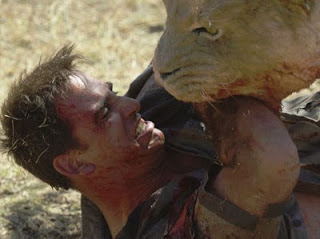 |
Humans are much of a match for most large predators, we have to rely on our wits to get us out of dangerous situations. Or better yet, KEEP us out of dangerous situations. Don?t worry, no humans were harmed in the making of the photograph; it is a re-enactment for a Discovery Channel program. |
The answer to all ? Homo sapiens. We?re a mess when it comes to protecting ourselves physically. Most mammals have defensive behaviors and some have built in protective anatomy, but not us. If we had to survive by fighting off a tiger, our species would be nothing but a footnote in history. We need some camouflage - or maybe a superpower.
Some mammals have super sight. Most prey animals have their eyes on the sides of their heads to scan 180? or more of the environment, but ours are on the front of our faces in order to allow for binocular vision and good depth perception. Don?t get cocky; even though we may be considered a predator, think of all the animals you wouldn?t want to run into in a dark alley.
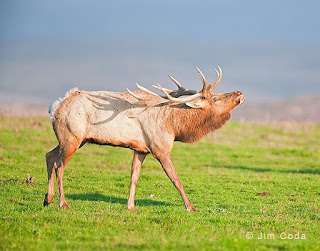 |
Sense of smell in some mammals is quite developed. Here a tule elk raises it nose to catch chemicals in the breeze ? always on guard for bears, and for good reason. Bears are the champion smellers. Their brain is 1/3 the size of humans, but 5x as much volume is devoted to smell. |
But most mammals use other senses as well. Noses can be even more important than eyes. Chemicals from skin lipids or urine can identify predators before they are seen. Changing concentrations from spot to spot can provide evidence of time and direction; merely sensing a predator's odor alone would cause too many false alarms and wasted energy.
Added to the wealth of information prey mammals may pick up is sound. Again, differences in timing and loudness can give clues as to direction and distance, as we discussed with owls. Hearing is especially important for nocturnal mammals, as sight is of less value in the dark? duh!
Many animals have a way of avoiding predators even if you come into their range. Things like camouflage can help; predators may not attack if they can?t see you, even if they know you are there somewhere. But if they do spot you ? it becomes decision time. Fight or flight are the two basic choices, although there are variations on these themes.
Some animals will freeze, based on the idea that predators are looking for grazing or some other motion. When motionless, camouflage has a better chance of working. Others choose speed to survive. Rabbits, gazelles look to outrun the predator, and turning on a dime is maneuver that a chaser may not be able to follow.
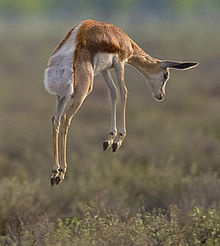 |
Pronking (stotting) is a defensive behavior meant to display fitness. I am not aware of a study that shows that he who pronks highest is least apt to be attacked, but that is the idea. See the video for a good example. |
Likewise, elephants and rhinos will charge you with loud noises and clouds of dust. Same with bulls. These are called honest displays. They are true representations of fitness and/or aggressiveness. Honest displays can be used defensively as well. Stotting (also called pronking or pronging) is used by many species of gazelles, springboks and deer ostensibly to impress predators with their fitness. They bounce as high as they can using all four legs at once.
If they can expend this kind of energy when a predator is near, it must mean that they are the most fit; predators shouldn?t waste time trying to catch them. Many studies have been carried out to see if this type of behavior is stable in a species. My explanation is ? if it didn?t work, they would all be dead or wouldn?t do it anymore. But other researchers want to be a little more specific.
A late 2012 study used game theory to predict the stability of signaling in prey animals. Their model showed that variable intensity signals would be stable; those where greater energy is expended in signaling the nearer the predator is to the prey. They also predict that fake signals (dishonest signals) would not be as stable because of wasted energy, as would on/off signals where an intense response would be elicited no matter the relative danger.
Sometimes signaling is not enough; pragmatic defenses are needed. Gorillas are strong, elephants are huge, porcupines have quills. These are all brilliant adaptations that serve their purposes, but I stand in awe of the mammalian biochemists.
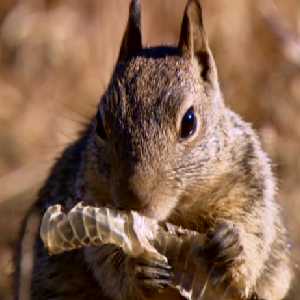 |
Here is an example of a dishonest signal. The squirrel chews up old rattlesnake skin and spreads it over its fur. Now he smells like a rattlesnake; predators are much more likely to leave him alone. Dishonest --- but smart. |
Skunks are very confident in their chemical defense, as well they should be. However, they may be a little over confident. It is hypothesized that many skunks are hit by cars because they see oncoming cars as just another predator that will cringe and run when faced with their backside and raised tail ? oops.
Some mammalian chemical engineers are true exceptions. Did you know that there are venomous mammals? For one, there is the solenodon (solen = slotted, and don= tooth), a mammal that we were sure was extinct. Two species are now known to still exist, the Cuban solenodon, and the Hispaniola solendon, but they are exceedingly rare and are usually spotted only years apart.
The solenodons are very old species and have retained their ancient traits, this makes them interesting as example of what mammals were like during the dinosaur age. They have poisonous saliva that they grind into their prey with their slotted teeth, but this does not save them from their own predators. They have a tendency to stop and hide their heads if attacked; this is a less than optimal defense. Therefore, it's a good thing that they are nocturnal.
There is also the male platypus. We met the platypus when we discussed genomic imprinting, but being egg layers with the potential for parthenogenesis are just some of their exceptions. On each hind leg they have a talon or spur that is connected by a duct to the crural gland in their thigh. The venom, which is actually a mixture of many toxins, seeps out onto the spur and is transferred into the wound when the platypus kicks at a target.
But only the males have the spurs and toxin in adulthood. Females are born with the spurs, but they soon fall off. This is related to the notion that the venom is not fatal, it just hurts very badly, and that the venom is made mostly in the mating season. Put these three clues together, and the answer says that the venom is used in mate selection. The platypus has few predators, and they don?t need to subdue the worms and tiny shrimp they eat. But they do have rivals for females. A 2009 studyspeculates that the non-lethal venom probably developed as a mating selection device. The male who isn?t cringing in pain wins the girl. This is the only instance known of a temporal cue for venom production.
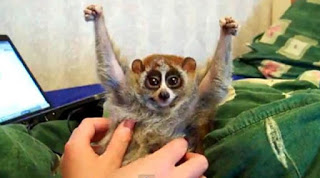 |
Here is a slow loris that is more than willing to show you his toxin glands. They are not covered with fur and are located halfway between his armpits and his elbows. I?m not sure I would be handling him without gloves. |
The slow lorises (all 9 species, living in southern Asia) will lick their young before stashing them away to go find food, protecting them from potential predators in a poisonous kind of way. They will also bite strongly and hold on, passing the toxin into the wound, which makes it a kind of venom.
To add to our mammalian exceptions, we should spend a minute talking about the mammals that are strictly poisonous. Two examples are known, both being toxin sequesterers. They don?t make their toxin, they gather it from another natural source and then use it for their defense.
One example is the southern vole (Microtus levis). They eat grass, and sometimes the grass is infected by a poisonous fungus. For most voles, the fungus is lethal, helping the fungus protect its grass habitat, but the southern vole is immune to the poison. In fact, the fungus toxin protects the voles from their main predator, the least weasel. One studyhas investigated why, with mixed results.
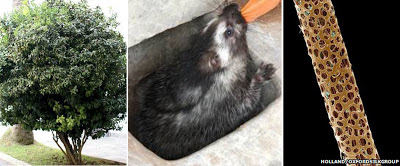 |
On the left is the Acokanthera tree. It looks harmless but is deadly. However, the fruit is said to he edible and is used as medicine ? not for me it isn?t. In the middle is the crested rat. He has adopted black and white colors, much like the skunk. Bright colors don?t work so well when you are a crepuscular animal. On the right is one of the hollow flank hairs of the crested rat that holds the oubain toxin. |
Lastly, there is the African crested rat (Lophiomys imhausi). A recent study has shown that this small mammal likes to moon its potential predators. It spends a lot of its time gnawing on the bark of the Acokanthera tree, which contains oubain, a curare-like toxin. It spreads this chewed up mess on its flanks, which contain specialized, hollow hairs (see pictures above). The hairs soak up the toxin, and then when threatened, the rat turns its flanks to the predator. This, along with its coloring and thick fur and skin in that area, is enough to keep the crested rat alive until the predator learns its lesson ? it dies from the toxin.
Next week, how about discussing more exceptional animals - venomous amphibians and lizards?
For more information, see:
Mammalian defenses ?
http://listverse.com/2010/05/18/top-10-mammals-with-odd-defense-mechanisms/
http://books.google.com/books?id=2i0tCgP_GbwC&pg=PA404&lpg=PA404&dq=mammal+defenses&source=bl&ots=hc7hfPIHNP&sig=4D0Mq2T7gSEufNRbFWY7oOr0pr4&hl=en&sa=X&ei=M24mUefSDYHT0wGT2IGQCA&ved=0CGAQ6AEwBw
http://www.nature.com/scitable/knowledge/library/behavior-under-risk-how-animals-avoid-becoming-23646978
http://www.pbs.org/wgbh/nova/education/activities/2714_eden.html
http://www.google.com/url?sa=t&rct=j&q=&esrc=s&source=web&cd=1&ved=0CDAQFjAA&url=http%3A%2F%2Fwww.dec.ny.gov%2Fdocs%2Fadministration_pdf%2Flpwilddefenses.pdf&ei=dG8mUYyiEo2v0AHE0oEo&usg=AFQjCNHThUEJTvT6E-YvKkaMtxlCrHEcmg&bvm=bv.42661473,d.dmg
Signaling theory ?
http://en.wikipedia.org/wiki/Signalling_theory
http://octavia.zoology.washington.edu/handicap_old/handicap_intro_2.html
http://www.google.com/url?sa=t&rct=j&q=&esrc=s&source=web&cd=3&ved=0CEEQFjAC&url=http%3A%2F%2Fsmg.media.mit.edu%2Fclasses%2FIdentitySignals05%2FNotesOnSignaling.pdf&ei=-G8mUeWvMIWN0QHRrYFg&usg=AFQjCNER31tSco2glOAVQoKR67pnHKkJVQ&bvm=bv.42661473,d.dmg
http://www.psych-it.com.au/Psychlopedia/article.asp?id=375
http://www.replicatedtypo.com/category/101/animal-signalling-theory
www.biology.ufl.edu/.../Dishonest%20Signal%20Presentation.pdf
http://www.animalbehavioronline.com/deceit.html
- When The Early Bird Is Also The Night Owl
Biology concepts ? cathemerality, circadian rhythm, adaptation, predator/prey relations One carnivorous and three vegetarian friends stranded on a island ? what could go wrong? The 2005 movie ?Madagascar? had some animals that we recognize from zoos;...
- It?s An All Or None Proposition
Biology concepts ? toxin, venom, cnidarians, kleptocnidae In our discussions of venoms and toxins we have looked at many groups (phylums) of animals. In each phylum we have identified at least one venomous animal. We have talked venomous amphibians (frogs,...
- Sneaky Snakes: Biters, Boobytraps, And Spit
Biology concepts ? venom, toxin, poison, fangs, evolution, toxicofera hypothesis The California Red Sided Garter Snake is one beautiful reptile. It has round pupils, so it might be non-venomous, but it has a highly patterned and bright colored body,...
- A Salamander Superhero?
Biology Concepts ? primary and secondary toxin, passive and active defense, venom, poison, toxin salamander, newt Wolverine is a comic book character, as well as a recurring movie character played by Hugh Jackman. It?s hard to believe that this is the...
- One Man?s Poison Is Another Man?s Cure
Biology concepts ? toxin, poison, venom, LD50, ED50, therapeutic index The skull and crossbones is the most recognized symbol for poison. It originated at the entrances of Spanish cemeteries, so it has always been associated with death. With advent of...
